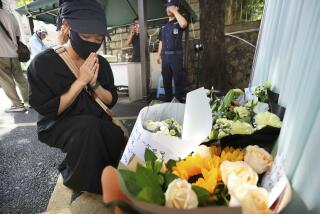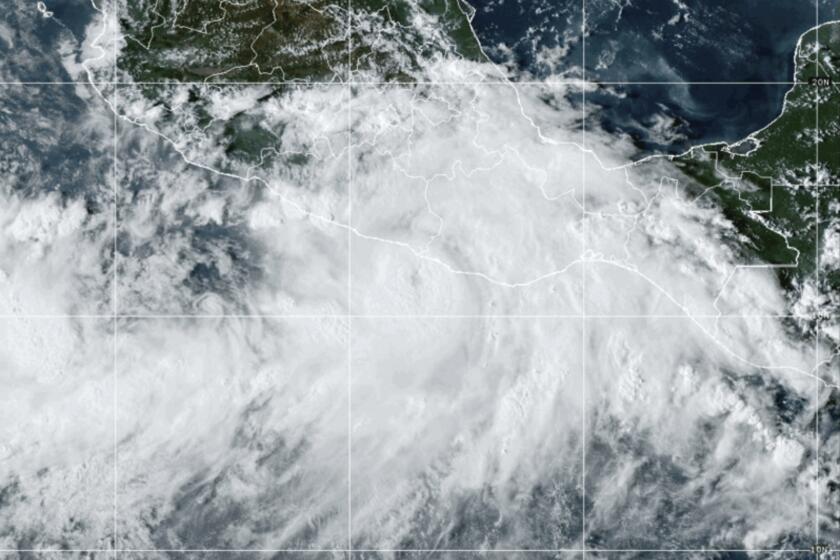Trying to Draw the Line : Culture: More Americans are claiming Indian ancestry, but tribes, eager to protect their resources and integrity, have strict rules about who belongs.
When journalist and law student David Gomez spent part of the summer of 1991 researching a story on American Indians in the Bay Area, he was left wondering if they were really Indians.
Gomez, whose mother is Navajo and whose father is Taos, found the Indians he interviewed unlike those he knew back home. This group’s ancestors had intermarried with non-Indians, lived in the suburbs of San Jose, spoke mostly Spanish and preserved few, if any, tribal practices.
He had bumped up against a perplexing question: What is an Indian?
Is a city dweller of Indian ancestry who has abandoned tribal cultural and religious practices really an Indian? What about someone of mixed parentage who lives on a reservation and practices tribal traditions?
In an era in which more people than ever are claiming Indian ancestry, the answers are important for two reasons.
On a practical level, tribal governments must be able to identify members so limited resources can be put to the best use. Tribes want to ensure, for example, that health care and educational benefits intended for Indians are not claimed by anyone else.
But cultural integrity is the deeper issue. After 500 years of contact with European culture, many Indian and Eskimo tribes are fighting to protect their languages and religious traditions from outside influences. In some tribes, particularly in the East, few full-blood members remain after centuries of intermarriage with other tribes or non-Indians.
“Indians are the only people who have pedigrees, like animals do,” observes Gomez, who had virtually no exposure to the Navajo side of his heritage. He was enrolled and raised at Taos Pueblo in northern New Mexico. Although he doesn’t speak Tiwa, he does participate in traditional religious rites and considers himself Taos.
Unlike other American ethnic groups facing cultural identity crises, Indian tribes are regarded by the U.S. government as sovereign entities with the power to define their own membership.
They use a variety of criteria to determine who belongs. The most common method is to require a specified proportion of Indian ancestry--a “blood quantum”--although the fraction varies for each tribe. Enrolled tribal members receive a “Certificate of Indian Blood.”
Not all tribes use that method. For example, tribes in eastern Oklahoma that were deprived of their reservations in the 20th Century ask enrollment applicants to prove they are lineal descendants of Indians listed on the rolls compiled in 1907 by the government’s Dawes Commission.
That helps account for the murmuring heard in Indian Country last month when the U.S. Bureau of the Census released its 1990 tabulations for more than 500 federally recognized tribes.
For instance, the bureau reported that 308,000 of 1.9 million Indians were Cherokee, placing that group ahead of the Navajo, which is generally considered the nation’s largest tribe.
But Cherokee and Navajo officials agree the Navajo tribe is larger. The Cherokee Nation in eastern Oklahoma has an estimated 140,000 members, and the Navajo Nation’s enrollment is about 219,000.
The confusion resulted because many people with only a small fraction of Cherokee blood can legitimately claim tribal ancestry. Many people not enrolled with the tribe identified themselves as Cherokees on the census, which asks people to identify their ethnic heritage.
R. Lee Fleming, the Cherokee tribal registrar, says Navajo officials complained after the census figures were released.
“I said, ‘Hey, we acknowledge that you have the largest population,’ ” he says.
Cherokee rolls are growing just the same. Fleming’s office has registered about 1,000 applicants a month since he took office in 1987. Eighty-five percent are newborns.
The tribe’s relatively liberal enrollment criteria reflect its history, Fleming says.
Although the Cherokee originated in the Southeast, in 1838-39 most of the tribe was driven to what is now Oklahoma along the infamous Trail of Tears. (An Eastern band of Cherokees still lives on a reservation in North Carolina.) In 1906 the federal government abolished the Cherokee reservation in the wooded hills of eastern Oklahoma, making tribal members U.S. citizens.
Although many full-blood Cherokees still live in the small towns that dot that part of the state, there has been much intermarriage with other tribes and non-Indians, Fleming says.
It wasn’t until the 1970s that the Cherokee Nation was reconstituted and granted federal recognition under the leadership of W. W. (Bill) Keeler, a former chairman and CEO of Phillips Petroleum, Fleming says.
Today, 65% of the tribe’s membership lives in eastern Oklahoma. The rest are scattered around the United States. Under the direction of Chief Wilma Mankiller, the tribe maintains a small land base and operates a number of businesses. It also acts as a contractor for federally funded programs that provide services to tribal members.
Given tough economic times during the last decade, it’s not surprising that some try to claim Cherokee ancestry in order to qualify for aid, such as health care and student loans, Fleming says.
“We have a lot of people who show up here who may be Indian, but they cannot prove it.”
Applications for membership often are filed by people who have embarked on genealogical searches.
“Every day we have people who contact us indicating that they’ve found they’re part Cherokee and wanting to know more about us,” Fleming says. The resulting tribal membership is a stew of cultural and ethnic influences. Says Fleming, “We have Cherokees who are Jews. We have Cherokees who are Episcopalians. We have Cherokees who I’m sure are Hindu.”
Amid the diversity, however, is an abiding concern that full-blood Cherokees are growing more scarce as well as a recognition that the tribal language and traditions must be preserved, Fleming says.
Adds tribal spokeswoman Kim Maloy, “People are asking, ‘Do we need to have a blood quantum--at least for (providing) services?’ ”
The preservation of language and culture also is a priority for the Navajo tribe, whose West Virginia-size reservation embraces northeastern Arizona and northwestern New Mexico.
“We were fortunate to maintain our traditional homeland,” says tribal spokesman Duane Beyal. “The culture is still strong; the traditions are still strong.”
The tribe has set a one-quarter blood quantum as the enrollment standard, Beyal says.
“To be enrolled in the Navajo tribe is a voluntary action in the first place,” he says. “When a Navajo marries a non-Indian or a member of another tribe, we have a form that asks whether you want your children to be enrolled as Navajos.”
Navajos traditionally have resisted migrating because their land, bounded by four mountains, was sacred. “As long as you stayed within these four sacred mountains, you would be protected,” Beyal explains.
That started to change during the Great Depression and World War II. When thousands of Indians returned to their reservations after service in the war, unemployment skyrocketed. Beginning in 1948, the Bureau of Indian Affairs offered Indians help in finding jobs in cities, launching a migration whose effects are still being felt.
Beyal was born in Los Angeles, where his parents had gone to seek work. The family soon tired of city living and moved back to the reservation.
“In these modern times, you see more and more people leaving simply because there’s a lack of development and education,” Beyal says.
Tribal records indicate that about 150,000 Navajo live on the reservation, with most of the rest living in towns or cities on its periphery.
Sooner or later, Beyal says, most Navajos return to the reservation.
“Our people long for their homeland,” he says. “There’s nothing like those red rocks at sunset.”
Living on the Pine Ridge Indian Reservation in South Dakota, the Oglala Sioux saw many tribal members depart for jobs in cities during the 1950s, says the tribe’s executive director, Michael Her Many Horses.
“We got Oglalas all over the place,” he says. “A lot of families did move off, and some made a go of it.”
Although the Census Bureau counted about 17,000 people claiming Oglala ancestry, Her Many Horses says about 20,000 live on the reservation. Many refused to participate in the census, fearing it might affect their government benefits.
The tribe enrolls anyone who is at least a quarter Oglala, has a parent who is a member and who is born on the reservation. Someone born off the reservation, even to parents who are members, must apply for enrollment, he says.
Her Many Horses says there is sometimes friction between full bloods and people who are enrolled members but only part Oglala.
“There is some animosity there,” he says. “Just like anywhere else, there’s some resentment about this. It flares up from time to time, but it’s kept in check. That’s my opinion, anyway.”
Despite the tribe’s stringent membership requirements, he says, “We have 30,000 applications for enrollment.”
Before “Dances With Wolves” and New Age interest in native spirituality there was reluctance to acknowledge Indian ancestry. That has changed dramatically, Her Many Horses says. “People (now) want to be identified if they have any Native American heritage.”
Cherokee Versus NavajoCHEROKEE NATION
* Capital: Tahlequah, Okla.
* Enrolled Membership (according to tribal officials): 140,000.
* Membership (according to U.S. Census figures): 293,074 (in more than 30 states).
* Enrollment Criteria: An applicant must prove that he or she is directly descended from an Indian listed on the Dawes Commission rolls of 1907.
NAVAJO NATION
* Capital: Window Rock, Ariz.
* Enrolled Membership (according to tribal officials): 219,000.
* Membership (according to U.S. Census figures): 219,198 (primarily in six states).
* Enrollment Criteria: An applicant must be at least one-quarter blood Navajo; for example, one grandparent must be full-blood Navajo.
More to Read
Sign up for Essential California
The most important California stories and recommendations in your inbox every morning.
You may occasionally receive promotional content from the Los Angeles Times.










